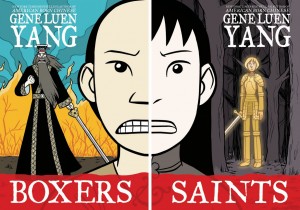 |
| Gene Yang. First Second Books |
Boxers and Saints’ double volumes revisit the Chinese Boxer Rebellion (1899-1900), sensitively and evenhandedly relating Chinese peasants’ perspectives from each side of the conflict. Boxers tells the story of the illiterate peasants tired of being hungry, tired of failing farms, and tired of Chinese Christian ruffians who would steal, cheat and beat them while under Western protection. It is young Bao who leads them as they turn into vengeful warrior gods, supporting fellow villagers and ridding China of the “white devil’s” influence. Saints tells the story of Four-Girl a peasant girl, who shunned by her family finds compassion and belonging with Christian converts. Both Four-Girl (who later assumes the Christian name Vibiana) and Bao believe it is their life’s mission to fight their foes and unite their divided and beloved China.
BACKGROUND
Factors Leading to Rebellion: Towards the end of the 19th century, China was experiencing a series of political, environmental and economic challenges, severely weakening the Ch’ing (Qing) dynasty. In addition to natural disasters (floods, famine and droughts), China fo
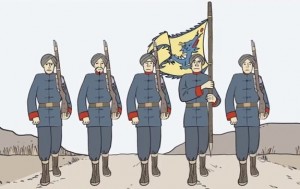 |
| Gene Yang, Boxers and Saints. First Second Books |
Western powers, with advanced weapons and modernized military, along with their profitable opium trade, were pushing China to accept foreign control over its economic affairs. Foreigners came and gained concessions from the Qing dynasty, and parcels of land were placed under their jurisdiction and functioned as colonies. Furthermore, missionaries came to China to convert the masses and merchants came looking for gold and trade opportunities.
While the Qing dynasty welcomed Western trade, opium infected China’s citizens affecting the country’s national defense and agricultural production. The ensuing Opium Wars (with Britain, 1839-42, and the Anglo-French, 1865-60) arose from China’s attempts to suppress the opium trade. A few decades later, the Sino-Japanese War (1894-95) weakened China even further. Japan in the late 19th century fought China for control over Korea, which was a Chinese tribute state. Under the Tientsin Convention of 1885, both China and Japan had the right to send troops into Korea. In 1894 a rebellion broke out in Korea (the Tonghak Rebellion) and Japan used this as a pretext for war, successfully gaining control in the area.
Severe drought, famine, and flooding, coupled with the growing spheres of foreign influence and dominance, led the struggling, starving peasants (primarily from the Shandong Province) to revolt. Furthermore, as their economic situation worsened, foreign soldiers and gangs of roaming bandits victimized peasants and villagers, and many citizens were deeply embarrassed by their nation’s weakness. Traveling Chinese opera troupes would go from village to village attempting to relieve the pressure and relive Chinese glory. These operas (an extension of their pop-culture) inspired many of the young men to relive these stories and myths and return China to its former prosperity and grandeur.
1989-1900 The Boxer Rebellion: The Boxer Rebellion was led by the Society of the Righteous and Harmonious Fist, a secret society of peasants whose goals were to rid China of foreign influence (political, religious, social, and economic) and to unite China, restoring it’s honor, long-held customs, and prosperity. The believed that martial arts training, discipline, and prayer would empower them to perform extraordinary feats of fight and flight, and that spirit soldiers would descend from the heavens empowering them to defeat the white devils,and the ”secondary hairy ones” ( Chinese Christian converts) and protect them from foreign bullets.
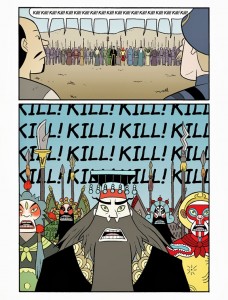 |
| Gene Yang, Boxers. First Second Books |
On September 7, 1901 the Boxer Protocol went into effect, calling for the execution of Chinese government officials who supported the Boxers and providing provisions for foreign troops stationed in Beijing and reparations of $330 million — more than the government’s annual tax revenue — to be paid to the eight nations over the next 39 years. The Qing dynasty, established in 1644, came to an end and China became a republic in 1912.
BOOK OVERVIEW
In Boxers, Yang deftly relates the Boxers’ perspective through the stories of Bao, an illiterate peasant boy who, like the Chinese gods of the opera and China past, fights for Chinese culture and honor. In Saints, Yang relates the Chinese Christians’ perspective through Four-Girl/Vibiana, who believes that she must become a “maiden warrior” like Joan of Arc, defending her home and country against the Society of the Righteous and Harmonious Fist.
Both Vibiana and Bao have dreams and visions of gods, both want
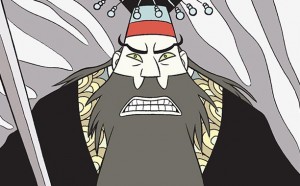 |
| Gene Yang. Boxers. First Second Books |
Both stories relay China’s struggle to maintain its culture and honor under increasing Western influences and incursions. Both stories relay the struggles of faith, racism, and the feeling of isolation and humiliation felt by Chinese peasants. Both stories emphasize the protagonists’ goals of strengthening and uniting China through misguided myth. Both stories relate the coming of age of their characters and of their country.
Here is a YouTube trailer and a more detailed look at their story.
When holding this enticing two-book set, I experienced a moment of panic — which one comes first? In truth (and hindsight) I don’t think it matters. Each tells the story of the Boxer Rebellion from their respective perspectives. Boxers is the story of oppressive events leading to the formation of The Society of the Righteous and Harmonious Fist and its quest to ‘free’ China. Saints relates why Chinese peasants converted (some for absolution of crimes others for a sense of belonging, community and belief) and tells of Christian persecution. Each book follows its respective path to Peking and the violent culmination of the Boxer Rebellion. That said, I might recommend reading Boxers first, as Saints seems to tie things up a bit tighter at the end.
Boxers tells Bao’s story. Bao, the third son in a family of three boys works on the family farm, often dreaming of spring, when the traveling opera troupes come to perform. In 1894 a Chinese Christian ruffian comes to the village, steals from them, and a fight ensues. Father Bey later comes to the village demanding “justice.” After Father Bey smashes the village’s earthen image of Tu Di Gong, the local earth god, the village constable finds himself helpless and while they would like to complain to the magistrate, the elders comment, “The Imperial government is like a toothless dog with these foreigners. The Chi’ing couldn’t even defend us Against Japan! Defeated by those midget barbarians! How humiliating!”
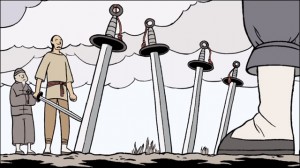 |
| Gene Yang, Boxers and Saints. First Second Books |
The remainder of the book relates the Boxers’ campaign to reclaim the might and honor of China. We learn about their disciplined training and belief in their mythical powers. And we are with them as they march across China, killing European missionaries, merchants, soldiers, and Chinese Christians in their quest to vanquish Western influences, defend their culture, and struggle for greater economic stability.
In Saints, it is the Chinese Christians who are the protagonists, as relayed through the struggles of Four-Girl, the fourth girl and only child to survive in her family. Her grandfather refuses to name and accept her because she was born the fourth child on the fourth day of the fourth month, and “four, after all, is a homonym of death…” At one point her grandfather calls her a devil and she struggles to find and embrace who she really is. Her mother takes her to an acupuncturist because she has adopted a “devil face.” There, she sees a crucifix and notices the image of “a small sculpture of an acupuncture victim” around the doctor’s’ neck. She comes back later to ask about it, and as he tells her more about Jesus and Christian faith, the doctor’s wife gives Four-Girl cookies. As she walks through the woods she has visions of Joan of Arc and returns to the acupuncturist to learn more.
Aside from the acupuncturist’s stories, lessons, and gospel, she learns that upon embracing the Christian faith she would be given a Christian name — she choses the name Vibiana. The cookies, the sense of belonging, finally having a name, and the influence of her encounters with Joan all push her to convert. The rest of the story follows Vibiana, along with the doctor, his wife and Father Bey as they struggle with their own issues around opium, belonging, community, faith, human rights, and violence experienced from the hands of the Boxers.
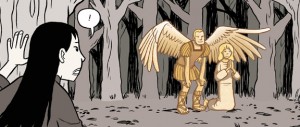 |
| Gene Yang, Saints. First Second Books |
Aside from the story lines and history, Boxers and Saints provides a stellar example of how we are the products of the world around us. The order of our birth, the names we are given (and try to live up to), the stories, songs, myths, and faiths we grow up with and hold as true, the political and economic situations we find ourselves in – all are integral in defining who and what we are. In creating a story in two volumes, Yang also shows us the importance of and challenge of trying to understand conflicting perspectives and cultural influences.Throughout Boxers & Saints, Yang relays:
- The importance of perspective and of considering diverse points of view;
- The struggle of individuals’, of communities’, and of a country’s sense of identity and purpose;
- The development of local and of national heroes and understanding how they came to be;
- The power of pop culture and environmental influences in shaping us;
- The powers and limits of local and national government in times of civic unrest and international imperialism;
- The powers and perils of rebellions;
TEACHING/DISCUSSION SUGGESTIONS:
The Power of Cultural Heritage, Faith, and Perspective
- Research the source of the name “Vibiana” (Saint Vibiana) and discuss why Four-Girl may have chosen this name.
- Research, compare, and contrast the stories of Saint Vibiana and Joan of Arc. What are their similarities and differences? What might the choices these women made tell us about Four-Girl?
- Chart the positive things the Boxers and the Saints did for their respective communities. Then chart the negative things they did to others’ as they responded to feelings of humiliation and persecution. Discuss who the “winners” and “losers” are — if any exist at all.
- Discuss what it feels like to have your rights and beliefs threatened. What are the various options one might take to protect them?
- Discuss how Four-Girl/Vibiana and Bao each felt helpless with their given circumstances. Discuss how and when your students might feel helpless. Discuss strategies and means of alleviating these feelings.
- Compare and contrast how Bao and Four-Girl/Vibiana grow and change over the course of their stories. How are the choices they made similar, and how are they different?
- Discuss the power of pop culture in late 19th Century China, specifically the role Chinese opera and martial arts played for the Boxers. Discuss examples of how pop culture influences people today.
- Discuss the role of superstitions as seen in the Boxers & Saints (for example: Four-Girl’s being fourth how four is equated with death; the use of chants and incantations; the power of visions), versus how we express and deal with superstitions in our world today.
- Define and discuss racism and sexism
- Compare and contrast the different instances of discrimination, sexual discrimination, and racism presented throughout the two books.
- Discuss how hurtful racism can be — to those targeted as well as to the general population.
- Discuss the role racism played in the early 20th Century and the role it plays today (nationally and internationally) shaping policies and politics.
- Discuss the pros and cons of imperial coloniali
sm and how it created, shaped and influenced our world today.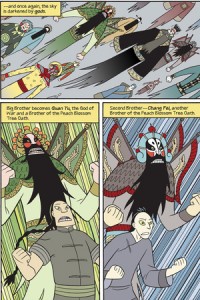
Gene Yang. Saints. Fist Second Books - Research (see links below) and discuss the events leading to the weakened Chinese government prior to the Boxer Rebellion and how China’s lose governing and colonization of the provinces fueled the growing resentment towards the West.
- Discuss local, national, and international ramifications of weak governance.
- Discuss the Five Edicts of the Big Sword Society (Honor your father and mother; Do not lust after women or wealth; Resist corruption wherever it’s found; Have compassion for the weak; Guard your fellow Brother-Disciples with your life). Compare them to the Bible’s ten commandments. If your students were forming a society for the betterment of others, what edicts or laws might they want dictating their actions and society.
- Discuss the power of these edicts and the power of commandments and laws. Why are they necessary?
- Discuss Gene Yang’s statement in Boxers, p. 312, “What is China but a people and their stories.”
- Plot and compare the author’s use of vocabulary, slang, idioms, color, and images as he relays the Boxers and the Saints’ respective stories. Is there a difference in their use of language? Why/why not?
- Boxers & Saints is rich in cultural stories. Have students collect their own respective family or community’s stories of beliefs, myths or faith.
- Search for and discuss Yang’s use of inference, simile, and metaphor
- Evaluate Yang’s use of language. You might:
- Search and discuss how the Chinese referred to Westerners and to each other (i.e. “pale-faced devils,” “black-headed people,” Master Big Belly, Father Bey is the “smasher of Gods,” a train is “the foreign devils fire cart” and others). Conversely, research/discuss how Westerners described the Chinese peasants in the early 19th century.
- Discuss Four-Girl’s reaction to a crucifix the first time she sees one (“an acupuncture victim”). Why did she view it this way?
- Discuss Yang’s use of language as Bao rationalizes why he could leave his father (Boxers, p. 60), noting the vow he made earlier to his father, “…was a vow made to another man, in another
Modes of Storytelling and Visual Literacy
In graphic novels, images are used to relay messages with and without accompanying text, adding additional dimension to the story. Compare and contrast the author’s use of verbal versus visual imagery. Discuss with students how images can be used to relay complex messages. For example:
 |
| Gene Yang. Boxers. First Second Books |
- In both volumes of Boxers & Saints, there are dream sequences. Discuss the role dreams play in relating the protagonists’ stories. Compare and contrast how the dream sequences are relayed in each book.
- Compare and contrast the colors used in Boxers versus the colors used in Saints. Why are they different, and what message is Yang trying to relay through his color choices?
- Discuss how the images complement the text, and ask students to add details and inferences of their own. For example, in Boxers, p. 84, the text reads: “Ever since Red Lantern left, food has been difficult to come by” and we see images of old and young villagers reaching for whatever bark is left on a lone tree in their village. How does this image support, complement, and reinforce the text?
- Compare and contrast the differences in how the Western god is
portrayed versus how the Chinese gods are portrayed. Why is this
important?
For greater discussion of literary style, related fictional histories and non-fiction texts you may want to read the following suggestions with Boxers & Saints:
- The Good Earth by Pearl S. Buck: About a farmer in a small village in China, post Boxer Rebellion, pre pre-revolutionary China. (Young Adult)
- East Wind, West Wind by Pearl S. Buck: About a family facing cultural change in early 20th Century China. (Young Adult)
- Imperial Woman by Pearl S. Buck: About Tzu His, China’s last empress, who ruled during the 19th Century. (Young Adult)
- Spring Moon by Bette Bao Lord: About five generations of a Chinese family during the period of war and cultural change that took place during the late 19 and early 20 Centuries. (Young Adult)
- Spring Pearl: The Last Flower by Laurence Yep, Kazuhiko Sano (illustrator): About 12 year-old Chou Spring Pearl, who is taken to live in the home of her father’s wealthy benefactor after the death of her parents. Chou must deal with her own battles as the Opium Wars rage around her. (Ages 9-12)
Thank you so much for your visit. For a more detailed article, please see Using Graphic Novels in Education: Boxers and Saints.
In the meantime, please leave a comment before leaving.
Hi Meryl! Thank you for drawing our attention to this book, which I like to read. It is so difficult to take sides in conflicts. As long as I live I have seen wars all over the world. I don't know anybody who really wants war.
ReplyDeleteWhat happened to Bao and Vibiana still happens in any conflict ( Romeo and Julia).
I also read a couple of books by Pearl Buck.I liked them very much. Although I am not in favour of mission! Have a great week.
Wil, ABCW Team
We live in such a fascinating world.
ReplyDeleteI don't think anyone wants war but it seems conflict is always there.
I think these books would help me learn a part of history I really know little about.
Thanks Meryl for sharing the information.